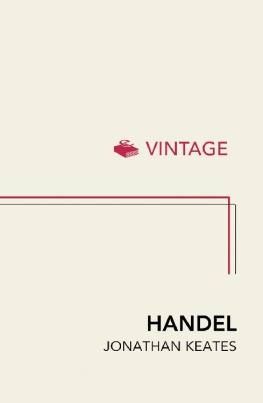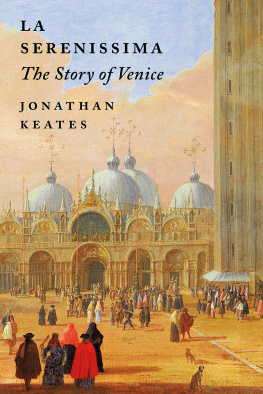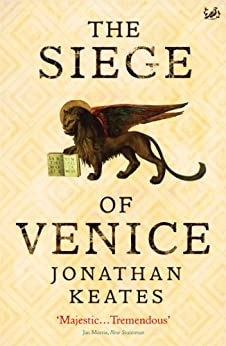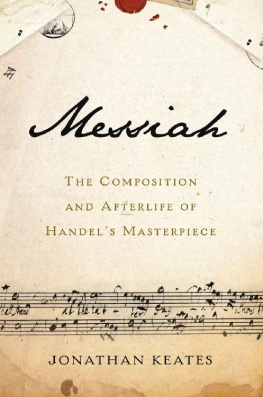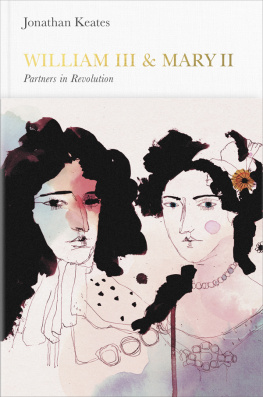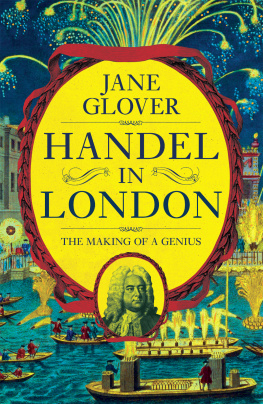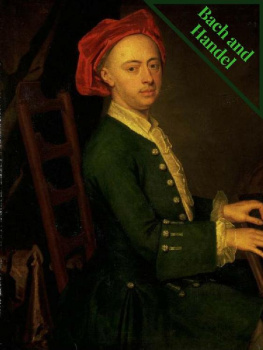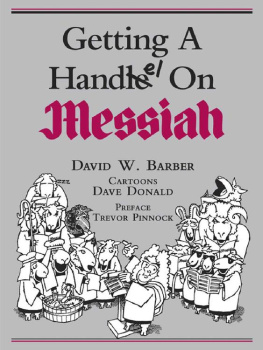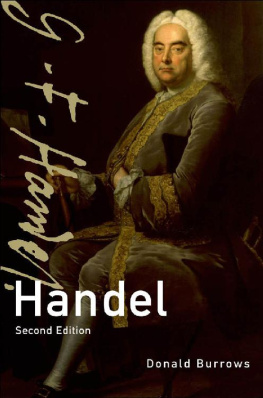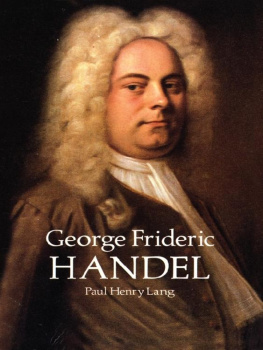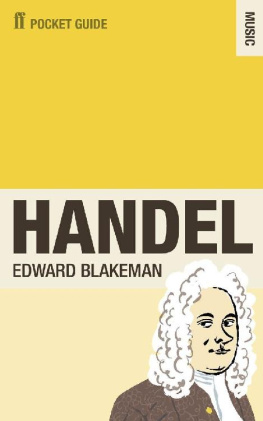Contents
About the Book
Jonathan Keatess original biography of Handel was hailed as a masterpiece on its publication in 1985. This fully revised and updated new edition published to commemorate the 250th anniversary of the composers death charts in detail Handels life, from his youth in Germany, through his brilliantly successful Italian sojourn, to the opulence and squalor of Georgian London where he made his permanent home. For over two decades Handel was absorbed in Londons heady but precarious operatic world. But even his phenomenal energy and determination could not overcome the publics growing indifference to Italian opera in the 1730s, and he turned finally to oratorio, a genre which he made peculiarly his own and in which he created some of his finest works, such as Saul, Messiah, Belshazzar and Jeptha.
Over the last two decades a complete revolution in Handels status has taken place. He is now seen both as a titanic figure in music, whose compositions have found a permanent place in the international repertoire, and as one of the worlds favourite composers, with snatches of his work accompanying weddings, funerals and television commercials the world over.
Skilfully interwoven with the account of Handels life are commentaries on all his major works, as well as many less familiar pieces by this most inventive, expressive and captivating of composers. Handel was an extraordinary genius, whose career abounded in reversals that would have crushed anyone with less resilience and willpower, and Jonathan Keates writes about his life and work with sympathy and scrutiny.
About the Author
Jonathan Keates is a prize-winning biographer and novelist, well known as a reviewer and as a writer on Italian culture and history. He teaches at the City of London School and is a Fellow of the Royal Society of Literature.
Also by Jonathan Keates
Non-fiction
The Companion Guide to the Shakespeare County
Italian Journeys
Tuscany
Umbria
Stendhal
Purcell
The Siege of Venice
Fiction
Allegro Postillions
The Strangers Gallery
Soon To Be A Major Motion Picture
Smile Please
List of Illustrations
. Handel, by Balthasar Denner, c. 17268 National Portrait Gallery
. Georg Hndel, by J. Sandrart The Trustees of the British Museum
. Cardinal Benedetto Pamphilj, by Jacques Blondeau The Trustees of the British Museum
. John Walshs score of the overture and arias in Rinaldo, 1711 British Library
. Lord Burlingtons House in Piccadilly, by Johannes Kip Guildhall Library, City of London
. Handels autograph score of Acis and Galatea, 1718 British Library
. Giovanni Bononcini, attributed to Bartholemew Dandridge Royal College of Music
. Francesco Bernardi, il Senesino, attributed to Antonio Maria Zanetti National Portrait Gallery
. Model of Handel for the Vauxhall Gardens Statue, by L. F. Roubiliac, c. 1737 Fitzwilliam Museum, Cambridge
. The Charming Brute (colour etching) by English School, (18th century) Private Collection/The Bridgeman Art Library
. Susannah Cibber, by Thomas Hudson, before 1749 National Portrait Gallery
. Elisabeth Duparc, La Francesina, by John Faber National Portrait Gallery
. Handels autograph score of Music for the Royal Fireworks, 1749 British Library
. Handels autograph score of Jephtha, 1751 British Library
To Gerard McBurney
Preface to the New Edition
Since 1985, when the first edition of this book appeared, Handel has been dramatically reclaimed, both by public awareness and through scholarly enquiry, like a submerged continent rising from under the tides of age-long neglect and ignorance. The opening of hitherto restricted archives, the recovery of lost documents, a closer attention to his creative processes and working methods, the establishment of a more precise chronology for his musical oeuvre, a firmer grasp of its context within European Baroque musical culture and of its impact on later composers, the study of his voluminous borrowings and ongoing identification of their sources, all these have enlarged our appreciation of his unique artistic achievement. More has been discovered, meanwhile, about Handels personal life, about his family background, education and travels, about his circle of English friends, his relations with the Hanoverian royal family, his professional career and his finances. The foundation of the Handel Institute and the opening of the Handel House Museum in London have deepened the perspective still further.
The one area which, for the time being and for the foreseeable future, remains stubbornly off limits to us is that of the composers sentimental attachments. Tiny scraps of evidence hint at the existence of a private life but so far they are nothing more than scraps. I remain unconvinced by the notion that Handels lifelong bachelor status must indicate either homosexuality or celibacy. Theorizing of this kind nevertheless reveals just how much, during the past twenty years, we have come to need Handel, eager for him to fit a multiplicity of stereotypes, models and constructs often less appropriate to his own era than to ours. At no time in the three and a half centuries since his death has his music held such a universal appeal, filling theatres and concert halls across the world.
It seemed a propitious moment to produce a revised version of my 1985 biography, updating and correcting it wherever possible and taking the chance to reappraise certain works in the light of new research surrounding them or of my changing experience as a critical listener. I have modified (slightly) what one of my original reviewers called the chromatic aspect of the books style and softened the combative approach I adopted at a time when Handel was still a victim of what might be called the iceberg principle, with only a small proportion of his works accessible above the waterline dividing the wider musical public from academic specialists. I hope that most of the pleasure and excitement I tried to communicate in the original text is still palpable. Rewriting this book has been more enjoyable for the experience of sitting down once again with the great and good Mr Handel.
The Liberal Arts
ON 2 MAY 1696, the Oberprsident Eberhard von Danckelmann, treasurer to the Margrave of Brandenburg, was sent a request for the payment of an outstanding bill; the letter ran as follows:
Most worthy sir, You have received from Herr Dr Wiesener a most humble request for payment of 100 thalers from the privy purse for the cure of Andreas Rudeluff, the knife swallower. Since I, as surgeon, have done my best in this two-year cure, and have brought out the swallowed knife from his stomach and body, with Gods help and a careful hand, and thereby cured him completely, and have most humbly given His Highness the knife in its original form in a case, in your presence, I would therefore most humbly request His Highness to grant me the favour, as much as seems fit, to recompense me for my painstaking operation, in your position as highly esteemed patron. I shall thank you most humbly, and shall ask God, from the depths of my heart, to give you health and long life. I remain Your Excellencys most obedient servant, Georg Hndel, medical practitioner.
The subject of the doctors operation was a sixteen-year-old peasant boy from the village of Maschwitz, near the city of Halle in Upper Saxony. One day, while playing with his friends, he had swallowed a horn-handled knife, and his parents had taken him, after ineffectual doses of warm beer and cotton wool, to Wiesener and Hndel, who then began their prolonged but ultimately successful treatment. The boy, who must have been remarkably tough, was slowly cured by the use of magnetic plasters, which drew the instrument out of the oesophagus into the throat. Finally, with the release of much
Next page
